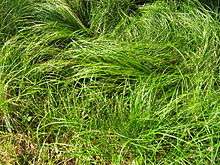Carex pensylvanica
Carex pensylvanica is a species of flowering plant in the sedge family commonly called Pennsylvania sedge (sometimes shortened to Penn sedge).[3] Other common names include early sedge, common oak sedge, and yellow sedge.[4]
| Pennsylvania sedge | |
|---|---|
 | |
| Scientific classification | |
| Kingdom: | Plantae |
| Clade: | Tracheophytes |
| Clade: | Angiosperms |
| Clade: | Monocots |
| Clade: | Commelinids |
| Order: | Poales |
| Family: | Cyperaceae |
| Genus: | Carex |
| Subgenus: | Carex subg. Carex |
| Section: | Carex sect. Acrocystis |
| Species: | C. pensylvanica |
| Binomial name | |
| Carex pensylvanica | |
| Synonyms[2] | |
| |
Distribution
This plant is native to North America, especially eastern Canada and the eastern United States. Based on a census of the literature, herbaria specimens, and confirmed sightings, C. pensylvanica is found in Manitoba, Ontario, and Quebec in Canada; and in the United States it is most widely distributed in Connecticut, Illinois, Massachusetts, Michigan, Minnesota, New Hampshire, New Jersey, Pennsylvania, mainland Rhode Island, Virginia and Wisconsin. it is also known from northern Alabama, the western Carolinas, the mostly eastern Dakotas, northern and southern Delaware, northern Georgia, western Iowa, mostly northern Indiana, northern and eastern Missouri, mostly central and eastern Ohio, and mostly central Tennessee. It is also found in Arkansas, Kentucky, Maine, Maryland and the District of Columbia, New York, West Virginia, and Vermont. It has been reported from just one county, Lee, in the far northeastern portion of the state of Mississippi.[2]
Description
_in_East_Woods_of_the_Morton_Arboretum_-_Flickr_-_Jay_Sturner.jpg)
Pennsylvania sedge produces leaves up to 2 ft (0.6 m) long and 1 to 3 mm (0.04 to 0.12 in) wide that become arching at maturity.[5] It has culms (stems) 10 to 45 cm (4 to 18 in) long.[6]
Pennsylvania sedge blooms early in the spring, from April to June.[6][4] Each flower cluster contains one slender staminate (male) spike 10 to 25 mm (3⁄8 to 1 in) long above one to three shorter pistillate (female) spikes each with 4 to 12 florets. During the blooming period, the staminate spike produces slender cream-colored anthers, aging to light brown, and each pistillate floret produces three long white, thread-like styles. The scales underneath the florets are dark purple.[3][5]
Ecology
This competitive species is often found in large monotypic stands. It is mainly vegetative, spreading via systems of cordlike rhizomes. Shorter rhizomes produce tufts, clumps, and mats, and longer rhizomes form wide, matted colonies.[4]
References
- C. pensylvanica was first described and published in Encyclopedie Methodique. Botanique ... (Lamarck) 3(2): 388. 1792. Paris.
"Carex pensylvanica". International Plant Names Index (IPNI). Royal Botanic Gardens, Kew. Retrieved August 22, 2010. - "Carex pensylvanica". Natural Resources Conservation Service PLANTS Database. USDA. Retrieved February 7, 2010.
- Hilty, John (2016). "Pennsylvania Sedge (Carex pensylvanica)". Illinois Wildflowers. Retrieved August 22, 2010.
- Cope, A. B. (1992). "Carex pensylvanica". Fire Effects Information System (FEIS). US Department of Agriculture (USDA), Forest Service (USFS), Rocky Mountain Research Station, Fire Sciences Laboratory – via https://www.feis-crs.org/feis/.
- Chayka, Katy; Dziuk, Peter (2016). "Carex pensylvanica (Pennsylvania Sedge)". Minnesota Wildflowers.
- Ball, Peter W.; Reznicek, A. A. (2002). "Carex pensylvanica". In Flora of North America Editorial Committee (ed.). Flora of North America North of Mexico (FNA). 23. New York and Oxford – via eFloras.org, Missouri Botanical Garden, St. Louis, MO & Harvard University Herbaria, Cambridge, MA.
External links
- Carex pensylvanica in the CalPhotos Photo Database, University of California, Berkeley
- Flora of Wisconsin, Wisconsin State Herbarium, University of Wisconsin–Madison
